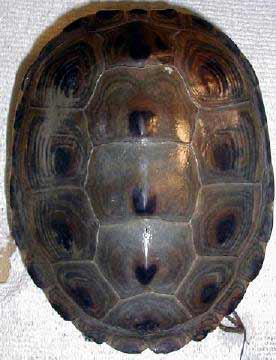Dark Night — 25 November 2000
While strong winds and high tides drive cold-stunned sea turtles
onto November beaches, perting our attention to these visitors,
exotic and tropical, we can’t forget Cape Cod Bay’s resident turtles — the
exquisite, yet threatened, diamondback terrapins. And while most
right-thinking terrapins have burrowed under the ooze for seven months of
well-earned brumation, their habitat warrants constant inspection to ensure it
remains hazard free and to collect the remains of turtles that may have
succumbed to some unfortunate circumstance this fall. Luckily, the sea
turtle patrols demand high tides and the salt marsh sweeps need low
tides.

One disadvantage of a new moon cycle in late November
at the northern end of the universe is trying to find a usable conjunction of
low tide and sunlight. Today, for instance, the morning low comes two and
a half hours before sunrise, and the evening low falls a half hour after
sunset. I chose evening. On the plus side, though, this latest
string of frigid days has coated the muddy muck with a thin layer of ice,
allowing deeper penetration into the marsh. That is, as long as you engage
in something akin to a “chicken walk,” placing each boot gingerly, yet
squarely on the ground ahead, spreading your weight as evenly as possible, and
quickly moving on before you break through the wafer crunch and sink into quick
mud. Perhaps we should trade-in our boots for chicken feet or snow
shoes.
Peering through the murky darkness, I spotted a dead
female terrapin lying plastron-up at the edge of the main marsh creek south of
Indian Neck’s Fox Island. A quick flashlight check of her marginals showed
she had been captured and marked previously: #388. Her history would have
to wait until I could search the database back home.

Terrapin 388 had first been observed on 12 July 1995 as
she came ashore on Lieutenant Island (across the channel from the Indian Neck
marsh where she now lay dead) to nest on a dirt road by Turtle Pass. At the
time she was 16.0 centimeters carapace length and 680 grams weight, both of
which indicate that this July afternoon a half decade ago marked her first year
of sexual maturity and her first nesting season. Since then, she had
increased about a centimeter in all dimensions, a normal growth pattern for
mature Wellfleet terrapins. And she died at the height of her productive
years.
 
Her body was mostly decomposed, yet her shell showed no
signs of predation or injury. The only marks she sported were some mating
scratches on her 5th (rear) vertebral. Unfortunately, her remains bring us
no closer to definitively establishing the cause of death for the 23 terrapin
carcasses we recovered so far this fall from the Fox Island Wildlife Management
area.
|